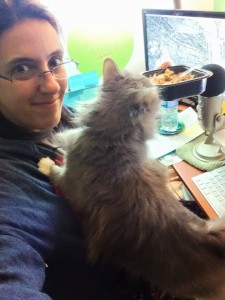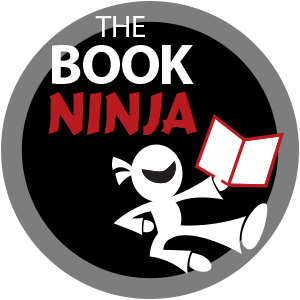As I sit down to write this article, my cat Adela Wesa (A-day-la Way-sa, Cherokee for “Money Cat”) is crying to be let into my office. It pains her to be anywhere her humans are not. And while she’s on strict orders from her doctor to stay sequestered to one part of the house, she doesn’t care. She wants what she wants and by golly, she’ll cry until she gets it, no matter what “it” is, and no matter that her humans have to teach a live audience with her wailing outside the office door…
The Selfishness of Cats and Readers
The bottom line is this… cats are selfish. They usually get their way (we humans are suckers for both their sad eyes and death glares) even if we have other plans. When they want snuggles, they get snuggles. When they want to be left alone, they find a corner inside the entertainment center behind the BluRay player where it’s next to impossible to pull them out. When they’re forced to do something they don’t want to do like wear the “Cone of Shame,” they protest all the way, claws swiping, then offer their humans plenty of death stares until the cone is removed. I’m quite sure Wesa (who is currently sporting the “Cone of Shame”) has plotted the demise of her humans dozens of times in the last few days. If it weren’t for the fact she knows we’re her source of food, we may have been found slain by thousands of claw stab woulds by now.
Why is it important that authors understand cats are selfish? While many writers have a tendency to midnight as crazy cat people, that’s not quite it. See, cats mirror humans in many ways, especially readers. Readers don’t care about you as a person (until you hook them in and they get more curious), and they really don’t care about your life story and how you survived XYZ trauma and how you got through “many hardships” blah blah blah. Sorry if that offends you, but it’s the truth. Besides the fact that life is hard for just about everyone on this planet (queue Princess Bride quote: “Life IS pain, Highness. Anyone who says differently is selling something.”) and your “life story” may not even compare to your readers’, they, like cats, only want to know what’s in it for them.
Why This Matters and is Dramatically Impacting Your Book Sales…
Most writers write for themselves. They write because they have a compulsion to do so. They just can’t help it. Writing is like air or food… it’s an essential element for their pure survival. And this is GREAT! Writing is an amazing form of expression and anyone who wants to write SHOULD write.
But… (and this is a BIG “but…”)
Writers who write only what they want to write (or read) should not be disappointed when they publish a book and want to sell their work, especially in the genre of non-fiction, and discover they can hardly give their writing away. Because writers who write due to the compulsion, the drive, the “need” to “share my story,” miss one crucial element that sets them apart from successful authors: the reader’s desire.
The reader doesn’t care about a no-name first-time author they’ve never met. They judge the book primarily on what’s in it for them. What are they going to learn? What take-aways will they get? The reader says, “Who cares that the author’s life changed… how will this change MY life?”
That’s what they want to know. So if all you do is share your story, with no success strategies on how what you’ve learned can work for them, no step-by-steps that will guide them along the path of triumph or self-discovery, nothing they can put into action right away and actually see results, you’re missing a huge opportunity to get more book sales. And more sales equals more readers which equals more reach for your message.
How Do You Reach the Cat-Like “Selfish” Reader?
The first mistake I see authors make when they craft their writing to what they think the reader wants to hear is that they instantly give the reader what they need. For example, an overweight reader who eats five pounds of french fries every week doesn’t need to get skinny, they need to make ongoing healthy eating choices. But who wants to choose a salad over waffle fries? I mean, really? So often times health coaches will jump into writing about what the reader needs (to get healthy, make healthy food choices, exercise, etc.) and skip right over what the reader really wants (to just plain lose weight and if they can eat anything they want while losing weight that’s ideal).
So here’s the super magic formula that works every time to sell more books and why industries such as wellness often sell weight loss instead of “get healthy…” Sell them what they want, give them what they need. While you’re writing your book and when it comes time to write that book description for Amazon, ask yourself, “What does my reader really want, even if it’s not what I think they need?” Answer that question and target your entire book and marketing copy directly to that “want” and you’ll capture more readers, spread your message further and impact more lives.
Secret #2 is to focus on the benefits. Too many times I see book descriptions that include bullet points like:
- Use Instagram as a promotional tool for your business.
- A list of to-do items before you get started.
- A customizable template to create your plan.
- How to handle returns.
- How to post correctly.
(Yep, these were all taken from actual published books.)
This style of feature-based points is all too common. Most of the time we focus on “what you will get” or “what’s inside this book” instead of “what you will gain” or “how this will change your life.” And that’s the difference between mediocre book sales and a powerhouse of book sales.
So how would those same bullet points look if they focused on the benefits to the reader (the “what’s in it for me”) instead of mere features? Let’s change them up a little:
- Easily engage tens of thousands of potential buyers on one of the most powerful social media platforms in existence.
- Quick checklist to help you launch your plan without wasting time or money.
- A time-saving plan-creation template you can complete in under 10 minutes.
- How to keep your customers happy and your returns at a minimum.
- The best way to engage your potential customers and increase your sales.
Yes, these points are longer, but do you notice the difference? Instead of just saying “how to post correctly” (WTH does that mean, anyway?) I changed it to the benefit of engaging potential customers (because who doesn’t want more customers?) and increasing your sales (because who doesn’t want more sales?).
Reaching out to your readers with what’s in it for them (the benefits) and selling them what they want while giving them what they really need for lasting change inside your book will dramatically increase your ability to get potential readers to say “yes” to becoming book-buying customers.
Your Turn!
How are you already putting this information into practice? What’s worked for you? Did you learn something new? Do you want to now re-write your entire book? 😉 Share in the comments below!
Do you have my Kindle book, Author’s Quick Guide to Engaging Your Fan Base? No? Grab your copy here and learn more ways to entice your reader!


Kristen – you’ll love Blaine Parker’s book on marketing: Be The Cat:
http://www.amazon.com/Be-Cat-Marketing-Courageous-Business-ebook/dp/B00IJLZYDA/ref=sr_1_2?ie=UTF8&qid=1458653274&sr=8-2&keywords=blaine+parker
Hi Kirsten…I love the Selfish Cat. We have one of those, plus my trusty sidekick: a 5 1/2 pound Chihuahua. I used to office in my basement, but when he decided that he didn’t like the basement…You’ve got it! He stood at the top of the stairs crying pitifully. So I would go up and get him. A few minutes later and he was back to his crying. Thus, I now office in my living room in my recliner. So who runs our household?
It’s not all bad. It’s lighter in the living room, because the basement has plenty of artificial light but no natural light. I find I appreciate the sunshine. It’s also easier to take care of my little boy’s needs, because he sits in the chair with me. It’s all in finding what their needs are! Then, meeting them! Oh, and isn’t that what your article is all about!
You got me…guilty of bad bulleting.
I think I finally get it. Thanks for the great examples of how to change up the boring bullet copy and make it interesting and helpful to the selfish readers.
Great Post!!!